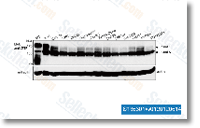It generates one deoxy D xylulose five phosphate through the transketolase type condensation of pyruvate and D glyceraldehyde three phosphate and it is also involved within the biosynthesis of thiamine and pyridoxal in bacteria and larger plants. There fore DXS appears to play a critical function linking isoprenoid and vitamin biosynthesis. 4 genes had been identified to encode for pu tative DXS isoforms. Most enzymes of your MEP pathway are encoded by single copy genes in flowering plants, whereas DXS is commonly encoded by a smaller gene loved ones. The genes of your DXS relatives display vary ential expression throughout plant improvement and in particular organs, suggesting a non redundant function and perhaps a purpose in production of specific isoprenoids.
Using the exception of Cla022299, whose expression didn’t differ during ripening, the other 3 sequences enzyme inhibitor were differentially expressed and induced for the duration of watermelon fruit ripening. This can be in agreement with what was discovered in to mato and pepper fruits. In tomato, the highest amount of DXS transcripts was detected with the breaker stage, then decreased all through later ripening. DXS mRNA was observed for being most abundant in youthful Arabi dopsis chs5 mutant, maize and peppermint leaves suggesting that its action is of essential value with the early phases of leaf and chloroplast development and confirming its organ and tis sue specificity. The truth that several water melon DXS genes are induced for the duration of ripening suggests a predominant part of members of this family in driving fruit carotenoid accumulation.
DXP is converted to MEP through the enzyme DXP reduc toisomerase encoded in watermelon through the gene sequence Cla019193 whose mRNA expression profile remained stable through fruit ripening. MEP is subsequently converted into IPP and DMAPP through the consecutive action of five independent enzymes, 2 C methyl D erythritol four phosphate Entinostat cytidyl for the putative enzymes MCT, MDS, HDS and HDR all showed a substantial enhance in expression levels in the course of ripening at the very least up to the pink stage. Cla011088 encoding to get a putative CMK, was stably expressed during watermelon fruit ripening. Geranylgeranyl diphosphate, the precursor from the synthesis of all plastid isoprenoids, is created by geranylgeranyl diphosphate synthase that cataly ses the condensation of three IPP and one particular DMAPP units.
The expression of Cla020121, encoding for a puta tive GGPS, greater within the transition in between the white along with the white pink stage of ripening, in agreement with the larger price of synthesis of lyco pene in between these transitional phases, then progres sively decreased on the pink as well as ripe  red stages. In other fruits this kind of as mango, GGPS levels had been secure through the entire fruit lifestyle. Given that GGPP is a frequent precursor to the synthesis of phyllochinones, tocopherols, plastoquinones, chloro phylls, gibberellins and carotenoids the expression professional files of genes which may possibly affect carotenoid biosynthesis via competition with phytoene synthase for GGPP were also analyzed.
red stages. In other fruits this kind of as mango, GGPS levels had been secure through the entire fruit lifestyle. Given that GGPP is a frequent precursor to the synthesis of phyllochinones, tocopherols, plastoquinones, chloro phylls, gibberellins and carotenoids the expression professional files of genes which may possibly affect carotenoid biosynthesis via competition with phytoene synthase for GGPP were also analyzed.
AMPK Signal
AMPK is formed by α, β, and γ subunits
